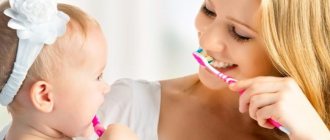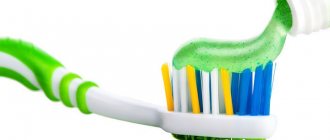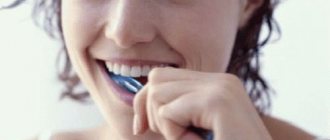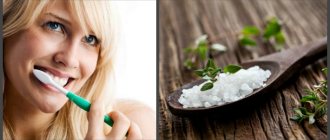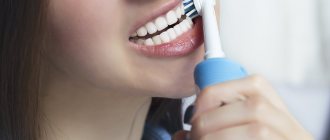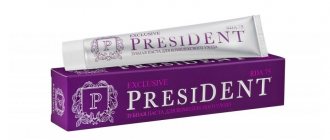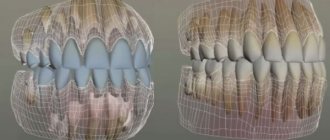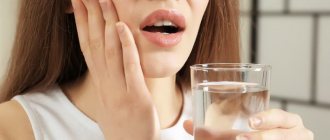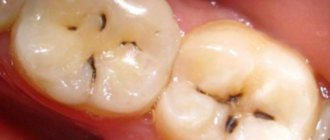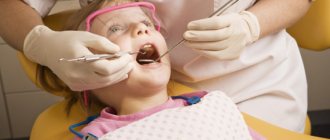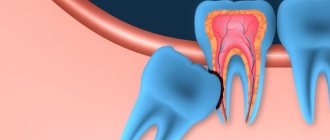The health of molars cannot but depend on oral hygiene in early childhood. To avoid frequent meetings between your baby and the dentist, it is recommended to brush your teeth regularly.
Parents quite often have a question: at what age do children have their teeth brushed? The baby's teeth should begin this procedure as early as possible, after the appearance of the first incisor. Typically, they appear at the age of 3-10 months.
If hygiene procedures begin at about three months of age, the baby will quickly get used to the manipulation. A slight pressure on the gums will serve as a massage and relieve itching during teething. And this will also prevent stomatitis, because it is from this age that the baby tries to taste hands and rattles.
Many parents associate the beginning of the procedure with the appearance of the first incisor. A simple way to determine whether a tooth has erupted is to knock on it with a spoon. But leaving during this period should be delayed. An awkward touch to the inflamed gum can cause pain.
Does my child need to brush his teeth?
There is an opinion in parent circles that there is no need to care for baby teeth.
By basing their opinion on the phrase “they will fall out anyway,” adults are mistaken. The oral cavity is an ideal place for bacteria to live and multiply. Failure to maintain hygiene leads to diseases of the gums and oral mucosa. With saliva, some microorganisms enter the stomach, sometimes causing inflammation and diseases of internal organs.
Leftover food is a breeding ground for microorganisms, which, in the process of life, form plaque. Acids are released from it. Exposure to acids released by plaque destroys thin enamel.
This leads to the formation of caries. A carious tooth is a source of bacteria and infections that can lead to stomatitis, pulpitis, and cause pain or discomfort in a child.
Teeth affected by caries are not only unsightly. They can lead to infection of the molars, which are located in the gums. And the early loss of baby teeth sometimes leads to improper eruption of permanent teeth, curvature and asymmetry of the bite.
Cleaning Rules
As the baby grows, hygiene attributes also change. Choosing them is not an easy task.
But even the safest brush can cause harm if you do not follow simple rules:
- The chewing surface is cleaned with circular movements, and the front part - only with vertical movements.
- The tongue also needs cleaning.
- Wash the brush thoroughly and do not forget to replace it with a new one regularly (once every 3 months).
- Dentists recommend brushing your teeth twice a day.
- The duration of the procedure should not exceed three minutes.
First year of life
When you hear the ringing sound of a spoon touching the first incisor, do not rush to run for a brush.
For infants up to one year old, there are their own care products:
- silicone fingertip;
- sterile bandage;
- dental wipes.
The advantages of the listed means are that they are worn on the finger. This allows you to feel the gums and adjust the pressure.
The most inexpensive way is to use a bandage or gauze soaked in water or soda solution. A small amount of bandage is moistened, wrung out and wrapped around the finger. The gums, tongue and inner surface of the cheeks are treated.
Purchasing dental wipes will hit your pocket much more. They are intended for one-time use, treated with a special antiseptic solution that is safe for the baby. Neutral in taste, will not leave any unpleasant sensations in the baby.
Children's stores have a huge selection of silicone fingertips. For the first manipulations, it is better to choose a smooth attribute.
For older babies, you can offer finger pads with silicone bristles. They are more reminiscent of a toothbrush and massage the gums better. After each use, wash in running water. Boil before first use.
Criterias of choice
When purchasing your baby's first brush, consider the following criteria:
- Softness of the bristles. The packaging should say “ultra-soft.”
- Quality of plastic. Make sure the handle is made of safe material.
- Size: head length - 15 mm, handle - 10 cm.
- Synthetic bristles. They are safer than natural ones. The latter take longer to dry and are a more favorable environment for the growth of bacteria.
- Convenience. Choose models with rubberized handles that will not slip out of your hands. In addition, the handle should be light so that the baby’s hands do not get tired while cleaning.
- Tongue attachment. On the back of the head there should be a raised silicone insert, which is used to clean the tongue and cheeks.
Today, a large number of toothbrushes for children are produced. Choose a model with an interesting design, for example, stylized as a cartoon character. This will make brushing your teeth more interesting for the child and he will quickly get used to the hygiene procedure.
Second year of life
The child grows very quickly and by the age of one year he can firmly hold a toothbrush in his hands. Of course, adults will have to manage with inept hands. Rinsing a baby’s mouth is also an impossible task, so it is necessary to use a fluoride-free toothpaste.
At this age, the main criterion for choosing a brush is its safety. What to pay attention to:
- stiffness of the bristles;
- handle with anti-swallowing, non-slip handle;
- size of the working part (head).
For a little person, choose a hygiene attribute with soft but elastic bristles. Hard hairs can scratch fragile enamel and injure the gums. Preference is given to models with the same bristle height (approximately 10 mm), in 3-4 rows.
The size of the working surface should not exceed 20 mm (approximately the size of two teeth). The rounded head will prevent injury to the gums.
Bright handles with cartoon characters attract children's eyes. It is inconvenient to use an accessory with a massive handle at such a young age. To prevent the brush from slipping, manufacturers provide a rubberized or ribbed coating.
A protective ring must be required.
At what age should you brush with toothpaste?
Toothpaste must be rinsed thoroughly. Children can cope with this procedure until they are two years old. The amount of paste at first should be the size of a pea.
The toothpaste for children under 3 years of age does not contain fluoride. Also, products with antiseptic components (for example, chlorhexidine or triclosan) are not suitable for daily use. They have a detrimental effect on local immunity and disrupt the microflora.
But there is nothing to worry about if your baby swallows a little baby toothpaste. The composition is absolutely harmless to health.
Baby and his first teeth
At the children's department of Dental Clinic No. 6 you can get detailed advice from a dentist on issues of child oral hygiene.
When a child cuts his first teeth, parents have new questions. When should you start brushing your child’s teeth, which toothbrush should you choose, which toothpaste is best for brushing, and is it dangerous if a child swallows the toothpaste? We will try to answer most of the questions in this article.
Start of oral hygiene. As soon as a tooth emerges from the gums (at 6-9 months of life), you need to start caring for it. After all, dental health begins at a very early age. Of course, at first you should simply wipe your teeth with a clean, damp gauze cloth or a special rubber brush placed on your finger.
The baby's first toothbrush should be soft and small, covering no more than two teeth. You can switch to it as soon as the baby gets used to manipulations in the oral cavity. He might even like it: his gums are itchy due to teething.
Choosing a toothpaste. Currently, children's stores offer a large selection of children's toothpastes for all ages. Experts advise paying attention to age-appropriate pastes ROCS, SPLAT, LAKALUT.
You need to squeeze a small pea of toothpaste onto the brush and press it down with your finger. A child's gums are more sensitive than those of adults, so brushing movements should be soft and smooth. The direction of movement of the brush is from the gum to the tip of the tooth; you need to “sweep out” food debris along the microgrooves, along the tooth.
Although you should not teach your child to swallow toothpaste, if this happens, do not be alarmed. All toothpastes intended for children aged 0 to 3 years are harmless and can be swallowed.
How to brush children's teeth. Cleaning frequency: 2 times a day, morning and evening. It's in parents' best interests to teach children independence, so give your child a toothbrush and toothpaste, take his hand, and brush together. Let the hand get used to the correct movements; when the child has enough strength, he himself will take the initiative. Allow him to “brush” his teeth himself first. However, until the age of 6-7 years, the parent needs to check and, if necessary, clean their teeth.
See your dentist at least twice a year, even if you don’t notice any problems with your child’s teeth.
Strong oral hygiene skills and habits are key to years of dental health.
Komarovsky's recommendations
The famous doctor Komarovsky recommends starting the process of oral care as early as possible.
But do not make this procedure violent. The process should give the little one pleasure and be a game. If the child resists, then you can wait until a more conscious age, up to 2-3 years. You will have to take care of your baby's teeth until he is 7 years old, until he learns to take proper care of them.
The task of parents is not to force, but to interest and teach hygiene.
But for oral health, certain conditions must be met:
- Diet mode (do not overeat at night, do not feed 24 hours a day).
- Clean cool air in the room, do not allow saliva to dry out.
- Drink clean water at night.
Each parent has the right to decide when to begin accustoming their child to daily oral care. Timely oral hygiene is the key to health and a beautiful smile.
How to brush children's teeth: when to start, what products to use
One of the most important moments in the development of children is teething. Many parents doubt whether they need to brush their baby teeth; they don’t know how to properly care for them, how to teach their child to use a toothbrush, when exactly to start brushing their children’s teeth: when to start, which ones for the child. Everything is important at this stage. You also need to know what dental and oral care products are used for children of different ages. Diseases of baby teeth can cause destruction of the rudiments of permanent teeth, as well as the occurrence of serious diseases of various organs.
In order for a child to have healthy teeth, dentists recommend:
When the first teeth appear, wipe them after each feeding with a damp sponge or gauze to remove food debris and prevent the formation of plaque. It is recommended to take the bottle with a pacifier from the baby immediately after feeding, drinking juices or sweet tea. Otherwise, the risk of caries formation increases.
From 10 months, start brushing your teeth 2 times a day with a soft synthetic brush using baby toothpaste, which will not cause harm to the child if he swallows it. After each meal, it is recommended to remove plaque from the teeth with a sponge soaked in water.
From 3 years of age, you can use a paste containing fluoride (“New Pearl”, “Doctor Hare”), applying it to a brush in the form of a pea. Fluoride accelerates the formation of tooth enamel, thereby protecting teeth from caries. It is necessary to ensure that the child spits out the paste and rinses the mouth thoroughly after using it.
At 6-9 years old, children should not only brush twice a day, but also begin using dental floss, as the gap between the teeth is reduced to a minimum. At this age, baby teeth are gradually replaced by permanent teeth.
For an older child, brushing teeth should become natural.
It is necessary to begin paying attention to cleaning the baby’s mouth as soon as the first milk tooth appears. On the one hand, this will introduce the child to proper oral care, on the other hand, this is a necessary procedure for maintaining a healthy oral cavity smell. Unbrushed teeth always lead to bad breath, as well as the proliferation of microbes, which can lead to not very pleasant consequences for the baby’s body. There are several important periods of a little person's age that you should pay attention to: The period is from 3 to 7 months. At this age, you need to begin to carry out the first manipulations with the child’s oral cavity. It is during this period that the baby begins to experience discomfort, accompanied by an increase in temperature, discomfort in the gums, or even pain. The whole reason is the calling of the first milk teeth. You can use special gels and ointments to alleviate the child’s condition. And in order to accustom him to brushing his teeth from a very early age, you need to use rubber fingertips, specially designed for gum massage. Period from 7 to 18 months. The food that the baby eats sticks to the teeth and creates a kind of plaque on them, which must be removed with a brush. Otherwise, such a plaque can create a favorable environment for the proliferation of bacteria, and thereby lead to
to the detriment of teeth. The so-called Priestly plaque in children can acquire a purple tint. It is better to use toothbrushes intended for the child’s age. Period from 2 years onwards. When the baby has crossed the age of two, he should already be accustomed to brushing his teeth 2 times a day. This habit will help avoid the appearance of caries and other undesirable consequences that may arise from the accumulation of microorganisms in the oral cavity.
The immutable basis of any preventive measures is daily oral hygiene, proper and balanced nutrition, and the use of fluorides as directed. Let's consider prevention methods in different age groups:
Oral care for newborns and young children (up to 3 years)
Dental care for children should begin with the eruption of the first tooth. Before teeth appear, oral hygiene can be performed with special wipes or a clean cloth moistened with water. Once all the teeth have erupted, soft toothbrushes (Curaprox or Nenedent) and age-appropriate toothpaste can be gradually introduced. If the child is breastfed, then he receives a sufficient amount of fluoride from the mother's milk (if she eats a balanced diet and takes vitamin complexes). When breastfeeding is completed, fluoride comes from food and water.
Attention, poor oral hygiene, frequent night feedings and constant drinking of sugary drinks between main feedings provokes the appearance of early caries!
At an early age, it is advisable to see the dentist once a year, starting from the appearance of the first teeth, unless the doctor prescribes a different schedule of visits.
Dental care for preschoolers (3-7 years old)
At this age, it is necessary to help the child brush his teeth; you need to control this process, checking the quality of brushing and the amount of toothpaste used. It is important to brush your teeth in the morning and evening (evening brushing should be done especially carefully). Recommended manufacturers of pastes and brushes: Curaprox, Rox, Splat. To check the quality of cleaning, you can use tablets or liquid to determine plaque "Curaprox", "Paro".
At this age, as a preventive measure for caries, on the recommendation of a doctor, you can use a paste with a fluoride concentration of 500 ppm to 1000 ppm. The dentist may recommend prophylaxis with Tuss Mousse gel (not suitable for children with cow protein intolerance) or coating the teeth with special varnishes containing fluoride, as well as remineralizing gels, for example, Rox.
Attention , poor dental care, snacking, drinking sugary drinks, eating disorders, a large proportion of food containing carbohydrates in the diet provoke the occurrence of caries!
In preschool age, it is recommended to visit the dentist 2-3 times a year. During this same period, it is advisable to see an orthodontist, especially if there are doubts about the correct development of teeth (the child sucks fingers or tongue, places the jaw incorrectly, teeth grow crooked, etc.).
Dental care for schoolchildren (8-17 years old)
Children this age can care for their teeth on their own, but parents or a hygienist can periodically check the quality of brushing using plaque tablets or liquid. It is good to use mouth rinses or special foams. Fluoride-containing pastes (1000-1500ppm) and Tuss Mousse gel applications can be used to strengthen tooth enamel (as prescribed by the dentist). At this age, it is necessary to pay attention to the condition of the gums: it is important to teach a teenager to use dental floss and an irrigator. Proper oral hygiene is especially important if you have braces. It is better to visit a hygienist to learn how to properly brush your teeth with braces. To help with self-hygiene, you can have your teeth professionally cleaned by a hygienist.
Attention , eating disorders, as well as poor hygiene when wearing orthodontic equipment worsen the condition of the oral cavity, increasing carious lesions!
At school age, it is advisable to see the dentist every six months, unless the doctor prescribes a different schedule of visits.
The immutable basis of any preventive measures is daily oral hygiene, proper and balanced nutrition, and the use of fluorides as directed. Let's consider prevention methods in different age groups:
Oral care for newborns and young children (up to 3 years)
Dental care for children should begin with the eruption of the first tooth. Before teeth appear, oral hygiene can be performed with special wipes or a clean cloth moistened with water. Once all the teeth have erupted, soft toothbrushes (Curaprox or Nenedent) and age-appropriate toothpaste can be gradually introduced. If the child is breastfed, then he receives a sufficient amount of fluoride from the mother's milk (if she eats a balanced diet and takes vitamin complexes). When breastfeeding is completed, fluoride comes from food and water.
Attention, poor oral hygiene, frequent night feedings and constant drinking of sugary drinks between main feedings provokes the appearance of early caries!
At an early age, it is advisable to see the dentist once a year, starting from the appearance of the first teeth, unless the doctor prescribes a different schedule of visits.
Dental care for preschoolers (3-7 years old)
At this age, it is necessary to help the child brush his teeth; you need to control this process, checking the quality of brushing and the amount of toothpaste used. It is important to brush your teeth in the morning and evening (evening brushing should be done especially carefully). Recommended manufacturers of pastes and brushes: Curaprox, Rox, Splat. To check the quality of cleaning, you can use tablets or liquid to determine plaque "Curaprox", "Paro".
At this age, as a preventive measure for caries, on the recommendation of a doctor, you can use a paste with a fluoride concentration of 500 ppm to 1000 ppm. The dentist may recommend prophylaxis with Tuss Mousse gel (not suitable for children with cow protein intolerance) or coating the teeth with special varnishes containing fluoride, as well as remineralizing gels, for example, Rox.
Attention , poor dental care, snacking, drinking sugary drinks, eating disorders, a large proportion of food containing carbohydrates in the diet provoke the occurrence of caries!
In preschool age, it is recommended to visit the dentist 2-3 times a year. During this same period, it is advisable to see an orthodontist, especially if there are doubts about the correct development of teeth (the child sucks fingers or tongue, places the jaw incorrectly, teeth grow crooked, etc.).
Dental care for schoolchildren (8-17 years old)
Children this age can care for their teeth on their own, but parents or a hygienist can periodically check the quality of brushing using plaque tablets or liquid. It is good to use mouth rinses or special foams. Fluoride-containing pastes (1000-1500ppm) and Tuss Mousse gel applications can be used to strengthen tooth enamel (as prescribed by the dentist). At this age, it is necessary to pay attention to the condition of the gums: it is important to teach a teenager to use dental floss and an irrigator. Proper oral hygiene is especially important if you have braces. It is better to visit a hygienist to learn how to properly brush your teeth with braces. To help with self-hygiene, you can have your teeth professionally cleaned by a hygienist.
Attention , eating disorders, as well as poor hygiene when wearing orthodontic equipment worsen the condition of the oral cavity, increasing carious lesions!
At school age, it is advisable to see the dentist every six months, unless the doctor prescribes a different schedule of visits.
